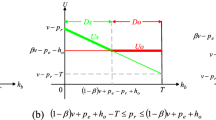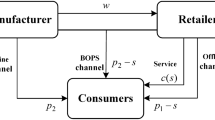Abstract
In this paper, we model the competition between two firms that each firm can choose a “buy online and pick up in store” (BOPS) channel strategy or an offline channel strategy. We find out when it is optimal for a retailer to offer a BOPS channel by comparing the equilibrium outcomes. Whether to adopt the BOPS channel depends largely on the difference between the inherent values provided by two firms. Further, we prove that a prisoner’s dilemma exists under certain condition when two competing firms offer the BOPS channel. We also examine the impact of heterogeneous channel acceptance on the profits of two firms. We find that when only a firm offers the BOPS channel, the higher acceptance of BOPS means the higher profit of this firm and the less profit of its competitor. However, when both firms offer the BOPS channel, whether a firm can benefit from the increase in acceptance of BOPS depends on the inherent value it provides.
Access this chapter
Tax calculation will be finalised at checkout
Purchases are for personal use only
Similar content being viewed by others
References
Feng, Y., Guo, Z., Chiang, W.K.: Optimal digital content distribution strategy in the presence of the consumer-to-consumer channel. J. Manage. Inform. Syst. 25, 241–270 (2009). https://doi.org/10.2753/mis0742-1222250408
Gao, F., Su, X.: Omnichannel retail operations with buy-online-and-pick-up-in-store. Manage. Sci. 63, 2478–2492 (2017). https://doi.org/10.1287/mnsc.2016.2473
Cao, J., So, K.C., Yin, S.: Impact of an “online-to-store” channel on demand allocation, pricing and profitability. Eur. J. Oper. Res. 248, 234–245 (2016). https://doi.org/10.1016/j.ejor.2015.07.014
Li, Y., Liu, H., Lim, E.T.K., Goh, J.M., Yang, F., Lee, M.K.O.: Customer’s reaction to cross-channel integration in omnichannel retailing: the mediating roles of retailer uncertainty, identity attractiveness, and switching costs. Decis. Support Syst. 109, 50–60 (2018). https://doi.org/10.1016/j.dss.2017.12.010
Gallino, S., Moreno, A., Stamatopoulos, I.: Channel integration, sales dispersion, and inventory management. Manage. Sci. 63, 2813–2831 (2017). https://doi.org/10.1287/mnsc.2016.2479
Gao, F., Su, X.: Online and offline information for omnichannel retailing. Manuf. Serv. Oper. Manag. 19, 84–98 (2017). https://doi.org/10.1287/msom.2016.0593
Gallino, S., Moreno, A.: Integration of online and offline channels in retail: the impact of sharing reliable inventory availability information. Manage. Sci. 60, 1434–1451 (2014). https://doi.org/10.1287/mnsc.2014.1951
Liu, Y., Zhou, D., Chen, X.: Channel integration of BOPS considering off-line sales effort differences. J. Syst. Eng. 33, 90–102 (2018). https://doi.org/10.13383/j.cnki.jse.2018.01.009
Jin, M., Li, G., Cheng, T.C.E.: Buy online and pick up in-store: design of the service area. Eur. J. Oper. Res. 268, 613–623 (2018). https://doi.org/10.1016/j.ejor.2018.02.002
Gao, F., Su, X.: Omnichannel service operations with online and offline self-order technologies. Manage. Sci. 64, 3595–3608 (2017). https://doi.org/10.1287/mnsc.2017.2787
Etzion, H., Pang, M.S.: Complementary online services in competitive markets: maintaining profitability in the presence of network effects. MIS. Q. 38, 231–248 (2014). https://doi.org/10.25300/MISQ/2014/38.1.11
Chen, J., Guo, Z.: Strategic sourcing in the presence of uncertain supply and retail competition. Prod. Oper. Manag. 23, 1748–1760 (2014). https://doi.org/10.1111/poms.12078
Jena, S.K., Sarmah, S.P.: Price competition and co-operation in a duopoly closed-loop supply chain. Int. J. Prod. Econ. 156, 346–360 (2014). https://doi.org/10.1016/j.ijpe.2014.06.018
Xiao, T., Xia, Y., Zhang, G.P.: Strategic outsourcing decisions for manufacturers competing on product quality. IIE Trans. 46, 313–329 (2014). https://doi.org/10.1080/0740817x.2012.761368
Ding, Y., Gao, X., Huang, C., Shu, J., Yang, D.: Service competition in an online duopoly market. Omega 77, 58–72 (2018). https://doi.org/10.1016/j.omega.2017.05.007
Zhao, M., Dong, C., Cheng, T.C.E.: Quality disclosure strategies for small business enterprises in a competitive marketplace. Eur. J. Oper. Res. 270, 218–229 (2018). https://doi.org/10.1016/j.ejor.2018.03.030
Hotelling, H.: Stability in competition. Econ. J. 39, 41–57 (1929). https://doi.org/10.1007/978-1-4613-8905-7_4
Yoo, W.S., Lee, E.: Internet channel entry: a strategic analysis of mixed channel structures. Market. Sci. 30, 29–41 (2011). https://doi.org/10.1287/mksc.1100.0586
Chen, L., Nan, G., Li, M.: Wholesale pricing or agency pricing on retail platforms: the effects of customer loyalty. Int. J. Electron. Comm. 24, 576–608 (2018). https://doi.org/10.1080/10864415.2018.1485086
Iyer, G.: Coordinating channels under price and nonprice competition. Market. Sci. 17, 338–355 (1998). https://doi.org/10.1287/mksc.17.4.338
Moorthy, K.S.: Product and price competition in a duopoly. Mark. Sci. 7, 141–168 (1988). https://doi.org/10.1287/mksc.7.2.141
Acknowledgments
This research was partially supported by research grant from the National Science Foundation of China (No. 71471128) and the Key Program of National Natural Science Foundation of China (No. 71631003).
Author information
Authors and Affiliations
Corresponding author
Editor information
Editors and Affiliations
Rights and permissions
Copyright information
© 2019 Springer Nature Switzerland AG
About this paper
Cite this paper
Wang, R., Chen, L., Feng, H., Nan, G., Li, M. (2019). Competitive Analysis of “Buy Online and Pick Up in Store” Channel. In: Xu, J., Zhu, B., Liu, X., Shaw, M., Zhang, H., Fan, M. (eds) The Ecosystem of e-Business: Technologies, Stakeholders, and Connections. WEB 2018. Lecture Notes in Business Information Processing, vol 357. Springer, Cham. https://doi.org/10.1007/978-3-030-22784-5_7
Download citation
DOI: https://doi.org/10.1007/978-3-030-22784-5_7
Published:
Publisher Name: Springer, Cham
Print ISBN: 978-3-030-22783-8
Online ISBN: 978-3-030-22784-5
eBook Packages: Computer ScienceComputer Science (R0)




